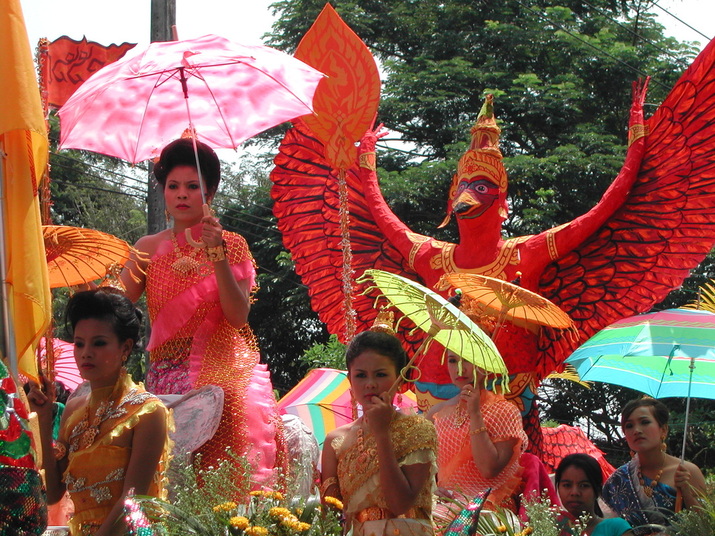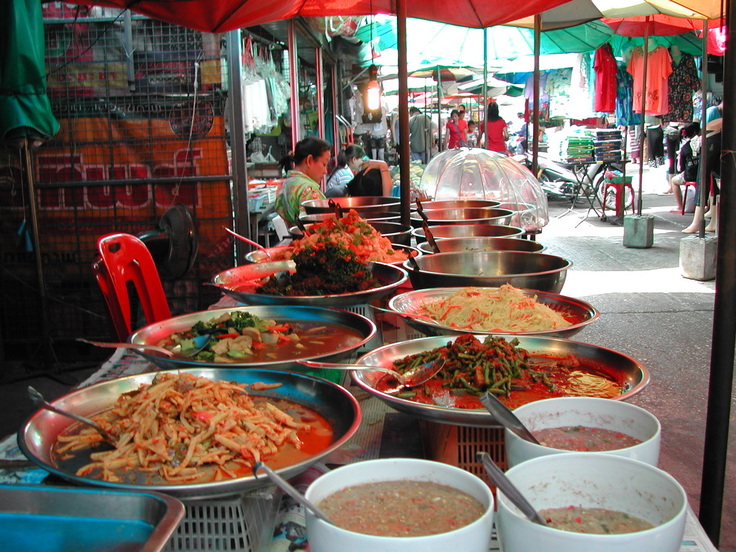 A float in the Sonkran parade
A float in the Sonkran parade With Songkran in full swing, my Thai lessons on hold and boredom setting in, I decided on the spur of the cuff to make a quick trip to Umphang, the only tourist–oriented destination around Mae Sot. Buckshot kindly lent me his spare motorbike, a Suzuki 100cc, that he guaranteed would carry me the 164kms to Umphang and back. If I’d thought about it in Imperial units, I might have reconsidered – 100miles on a 100cc bike – are you nuts? Especially since the bike model was the Suzuki “Crash”! I got more cheer from the brand of the flimsy plastic helmet, “Lucky”! Honestly, I’m not making this stuff up! But since this was my first venture on a motorbike, since I totaled my BSA Bantam in Glasgow, 25 years ago, I was raring to go. I traveled about 40kms, then started to climb into the mountains, which grew wilder and more dramatic as time went on. Halfway there, I passed Umphiem refugee camp, smaller than Mae La, but more remote, and apparently more crowded. I passed several NGO trucks on the road, whose mission it is to feed and care for these unfortunate people. Soon I was climbing into the cloud forest, where I would pass through belts of very cold air and reduced visibility. The scenery by now was spectacular, with cultivated valleys surrounded by jutting, jungle-covered cliffs. With only 40kms to go, everything changed in an instant – I was caught in a torrential downpour! Not too life-threatening, when you are stationary and the temperature is around 100 degrees F, you might think. But with night coming on and traveling at 60kms/hr in blinding rain, I started to get distinctly concerned. Very soon I began to shiver and my teeth started to chatter like castanets. Of course, there was not another vehicle on the road, they all had better sense, and above all, somewhere dry to go to. I had booked into the Trekker Hill Guesthouse, and not Hell nor high water was going to stop me getting there. Just as well, because soon there were torrents of floodwater crossing the road, where particularly steep side roads intersected my road. Just when I thought it would require surgery to remove my death-grip fingers from the handlebars, Umphang, in all its glory, hove into view, through the downpour. The Hill Trekker staff know a stupid fa-rang, close to hypothermia when they see one, and quickly had me in the hot shower, followed by a tasty meal. I expected to sleep well after my ordeal, but it was not to be. When the owner described the guesthouse to me on the phone, as ‘next to the Powerhouse’, I thought, “Oh, that must be a retro bar that specializes in the 70s power trio music of Hendrix and Cream”. I’m afraid not, old boy. It was the generating station for the whole damn town! The noise even overcame my high tech ear plugs, plus the vibrations ploughed right up through the pillow and on into my head. Umphang’s claim to fame is the proximity of spectacular waterfalls and exciting hiking trails, but the rainstorm had made access to the waterfalls impossible. So I did some off-roading on the bike and got to see what life is like for the really isolated Thai farmer. Hard scrabble. All in all, Umphang impressed me as dank, depressed little place, that has a ways to go before becoming the tourist destination it aspires to.
Songkran:
The Water Festival, celebrating Thai New Year happens between April 13th and 15th and this year was no exception. Traditionally, it was a time to visit and pay respect to elders, maybe gently wash the Buddha images in the Wat and generally clean house, literally and spiritually for the coming year. However, more recently, the festival has focused on the watery aspect, and how! For almost a week, young people, and not so young people, station themselves at the side of the road, beside 55gallon drums of water and drench anyone who passes. The unwary farang is a prime target. To counteract these stationary drenching facilities, gangs of youths ride around in Toyota pick ups, like they are Somali ‘technicals’, with two or more 55gallon drums in the bed and dispense their own drenchings. I had to eat dinner a couple of times completely soaked to the skin and dripping onto the restaurant floor. I have to say that it got a little old after a while. But the high point was the big parade, which took about four hours to wend its way down the main street. All morning, trucks full of villagers arrived from outlying areas, all dressed alike, to reinforce community bonding. Everyone in the parade wore the same shirt, hot pink with a procession of cartoon animals going round the bottom edge. The parade was made up of large elaborate floats with traditional Thai themes, often with massive sound systems, each playing a different Thai rock song. In between the floats were hundreds of people on foot, gyrating wildly to the pulsing beat(s), being soaked mercilessly by neighborhood kids. I even saw the town fire truck dispense a continuous dousing to the already-drenched revelers. Of course, such a bacchanalia needs an energy source, and the fuel of choice was Mekhong – the Thai whiskey. Really it’s more like rum, but the old guys and gals in the street were downing it like it was spring water, and then rocking out like youngsters!
Thai Language:
Since Songkran, BGET work has been slow, so I have decided to spend my last two weeks in Mae Sot trying to learn some Thai. I had not made a serious attempt before, because I was very tired each evening from the BGET computer work and, out in the field, I was surrounded by Karen, Mon and Burmese speakers, with hardly a word of Thai spoken. So, armed with my “Thai for Beginners” book and accompanying CD-Rom, I have dipped my toe into the stream, eddies and sloughs of paa-saa tai, Thai language. But its not at all easy. Thai is a tonal language and mispronunciation of any of the 5 tones can render your otherwise, well crafted sentence complete gobbledey gook. Take the word kaao, for instance. Depending on tone used, this may mean: fishy, news, rice or white. Or, how about bpaa, which can mean: to throw, forest, aunt and father (of a Chinese Thai person). I addition to the tones there are several other intricacies waiting to befuddle the unsuspecting student. Vowels can be long or short, and can be combined into sounds that, for me, involve quite a bit facial gymnastics to even approximate. I am getting pronunciation help from a very kind young man, who has the good grace to go under a name I can pronounce with ease, thank you, Nop!
Thanak and Whitening:
More of a Burmaway than a Thaiway, Thanaka is a beautifying whitish paste applied to the cheeks of children and women, which serves to protect them from the harsh rays of the sun. But it is not just smeared on, rather, it is applied as a cosmetic, in intricate swirls and geometric patterns. It is made by grinding up small branches of the Thanaka tree, and adding water to create a paste that has a scent reminiscent of sandalwood. I find it very attractive, as did the protagonist in “The Piano Tuner”, which I’ve alluded to before. The same cannot be said for the plethora of skin-whitening products, purchased and applied principally by Thai women, to achieve a more western appearance. I got badly sun burned one day, (I foolishly left the house without first applying my Thanaka!), and had to go to the big pharmacy in town to get some aloe vera lotion. I had to wade through about 60 brands of whitening cream products to find one measly bottle of 3% aloe vera. The creams all featured pictures of Thai women who were confusingly eurasian looking, and sported weird jail palors. I have to say that the world wide appeal of skin whitening products leaves me cold and disgusted. I can assure any of these beautiful ladies that they are much more attractive to me, the way God made them, before they apply that muck to their faces. Take it from this peely-wally wee Scotsman!
Plastic:
Plastic is mixed blessing in Thailand. On one hand, almost everything is made out of it, and that means cheap useful products for people with few resources. Every villager has plastic buckets, plastic plates, plastic sandals etc. A striking feature of both rural and urban Thailand is the profusion of blue PVC pipes strung up everywhere. Coming a variety of sizes, these blue snakes make their way from wherever there is a water source to wherever there is a water need. Water on one side of the road, house on the other? No problem, just run a couple of lengths of blue stick from one tree to another, and you’re done! And its versatile too. I notice that the bakers of naan bread keep short lengths of the old blue magic stick handy for those lumps of particularly recalcitrant dough. But there’s one Thai habit that butts right into this ocean of plastic and the resulting collision is smelly mess and ecological disaster. Thai people are in the habit of burning their trash, and that now includes all the cast off plastic bags, old flip flops, juice bottles etc. Often, even before the light penetrates my room, here in Fort Buckshot, I awake to the odor of melted plastic from our neighbor’s fire. Even though, in town, there is a regular and efficient trash collection service and plastic of all kinds has value on the recycling market, some homeowners still prefer to handle the waste disposal problem themselves, and just burn the whole damn lot!


 RSS Feed
RSS Feed